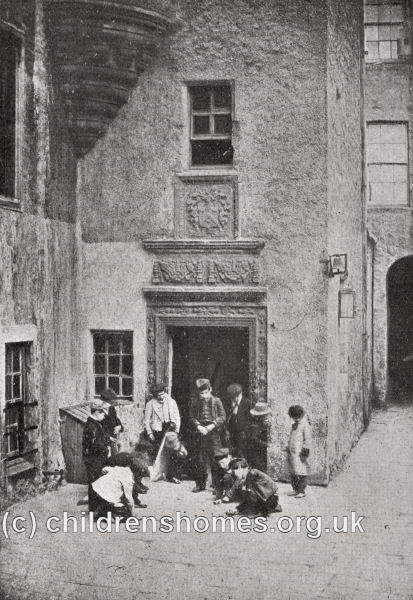House of Refuge, Aberdeen, Aberdeenshire, Scotland
In 1835, following a gift of 1000 guineas from Dr George Watt, the Provost of Aberdeen, James Blaikie, called a general meeting of the citizens to consider the formation of a House of Refuge to afford temporary shelter, food, clothing, instruction, and work to the destitute, and in particular to the young and friendless. As a result, Cumberland House in the Guestrow was leased for the purpose. A committee of ladies and gentlemen was elected and a paid superintendent, matron and chaplain appointed to supervise the institution.
In 1841, the Sheriff of Aberdeen, William Watson, established a boys' School of Industry as a branch of the House of Refuge, supervised by the same staff, but with its own committee and its own funds. It was initially located in Chronicle Lane, in the old Greyfriars Parish School. The inmates of the School marched to the House of Refuge for their meals. Those that were homeless also slept in the House of Refuge, while those with any kind of a home returned there at night.
In 1845, the School of Industry moved to Quaker's Court, at 55 Guestrow, neighbouring the House of Refuge. In 1853, when the rent of the School of Industry was raised, the establishment took over part of the House of Refuge premises. In 1866, the House of Refuge gave over the whole of the Guestrow sit to the School of Industry and leased its own premises at Ross's Court, Upperkirkgate.

House of Refuge, Aberdeen, c.1857. © Peter Higginbotham
By 1874 the Upperkirkgate property was in a ruinous condition, and there was too little room for industrial work. Accordingly the old Congregational Church in George Street was purchased for £1,600, and fitted up as a House of Refuge with workrooms. In 1881, the stables adjoining were bought for £900 for use as rag stores.
From the late 1860s, the House of Refuge provided shelter for homeless adult wanderers, and the necessitous who, being able-bodied, could not be relieved by the Parochial Board. In the year ending October 1896, 6,344 'casual' inmates passed through the Night Shelter, an average of 17 per night. There were also 26 inmates of more permanent residence.
By 1897, the House of Refuge had accumulated considerable debts. As the town had just erected a large Corporation Lodging House for casuals, it was resolved to sell the House of Refuge and pay off its debts with the proceeds.
Records
Note: many repositories impose a closure period of up to 100 years for records identifying individuals. Before travelling a long distance, always check that the records you want to consult will be available.
- None identfied at present — any information welcome.
Bibliography
- Cormack, Alexander Poor Relief in Scotland (1923, Wyllie & Son, Aberdeen)
Links
- None identified at present.
Except where indicated, this page () © Peter Higginbotham. Contents may not be reproduced without permission.


